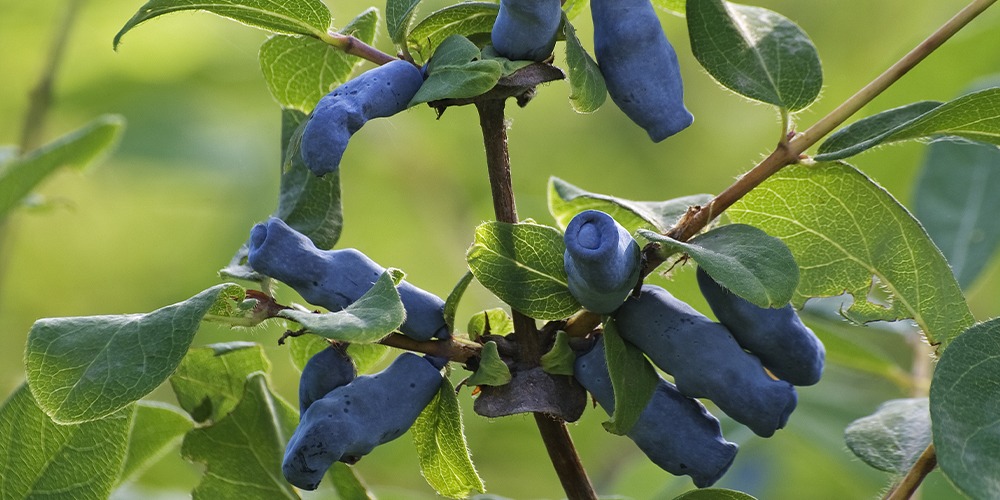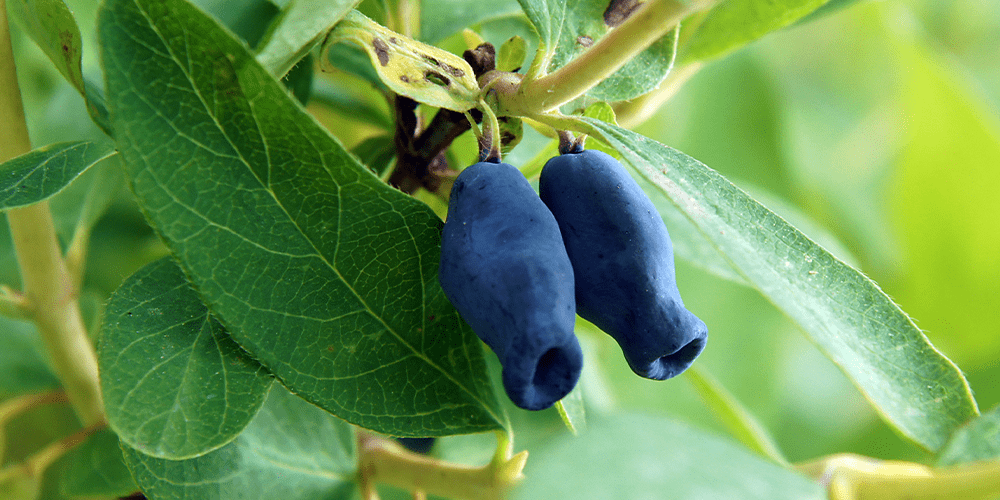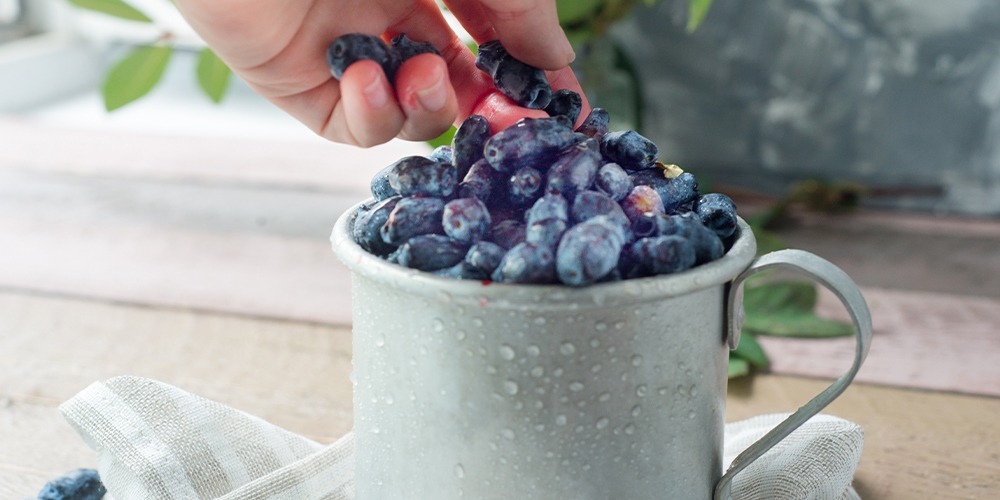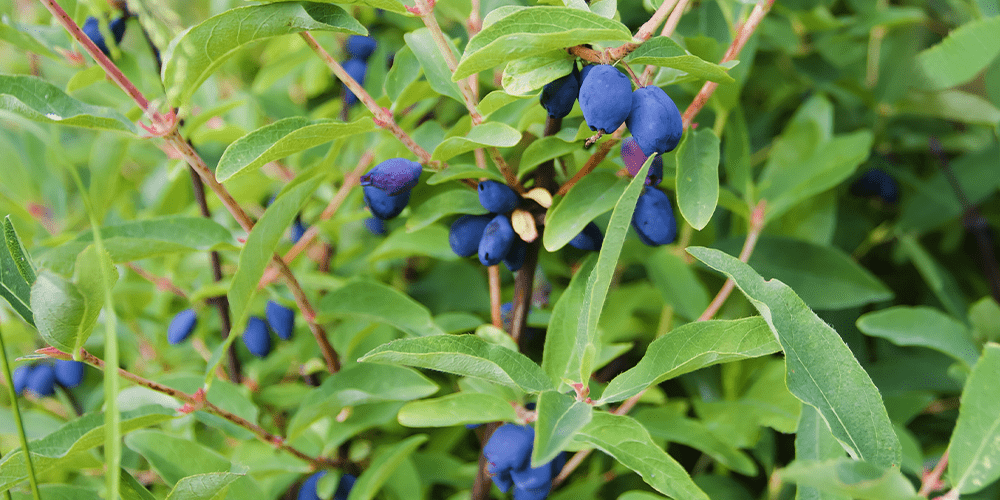
Are you growing haskap berries yet? If you’re not yet familiar with these peculiarly shaped beauties, they may soon become your favourite fruit crop in your garden. Tastier than Saskatoons, tamer than raspberries, and lower-maintenance than blueberries or strawberries, these amazing little berry shrubs are on the verge of becoming staples of the Edmonton garden. Here’s why you should plant some this year””and how to do it!
What the Heck are Haskaps?
Haskap berries (Lonicera caerulea), also known as honeyberries, are similar in colour to blueberries and similar in shape to kalamata olives, but it isn’t a relative of either. The plants are actually a cultivar of a shrub in the honeysuckle family that grows natively throughout North America, Europe, and Northern Asia. The berries of the wild plants have been popular in Japan for centuries; in fact, the word “˜haskap’ is Japanese for “berry of long life and good vision.”
While the berries have long been celebrated in the East, they weren’t as well-received in Western markets due to their bitter, astringent flavour. Modern-day “honeyberries” were developed from the Japanese parent plant by the Fruit Program at the University of Saskatchewan. Through extensive breeding, the U of S was able to produce an ideal shrub for urban gardens bearing delicious edible fruit. These Canadian-bred cultivars are now the parent plants of the haskap shrubs growing in gardens throughout the world!

Haskap Berries in the Landscape
Unlike Saskatoon berries and raspberry brambles, which tend to have wild spreading habits, haskap shrubs are pleasantly neat garden plants. Rarely exceeding 2 metres in height or width, they grow into tidy, rounded shrubs that fit handsomely in tiny urban gardens. If you’ve longed for a fruit-producing tree or shrub for your townhouse garden, you’ll be happy to hear that two bushes can easily fit in the space a single apple tree would take!
Due to their diminutive size, they are well-suited to mixed perennial borders. Their lovely yellow trumpet-shaped flowers are frequently visited by pollinators””a relief, as the shrubs do require cross-pollination for fruit to set!

Haskap Berries in the Kitchen
If you were curious about the way they look, you’re surely eager to find out how they taste! After all, a name like “˜honeyberry’ sounds very promising. To the delight of most people who try them, the fruit is often described as a mixture of a blueberry and raspberry. However, it has also been compared to other dark berries such as red grape, black currant, Saskatoon berry or chokecherry. The fruit is quite sweet, fairly tart, slightly astringent, and delightfully juicy. Each berry contains a small edible seed, a nice textural contrast to the fruit’s soft skin and flesh.
Better yet, they’re very good for you! The berries are very high in vitamin C, and like many purple fruits, contain high levels of antioxidants.
You can enjoy your “honeyberries” raw, dried, or press them for juice. They make fabulous jellies and jams, can be used like blueberries in baking recipes, and make great additions to smoothies. They’ve even been incorporated into ice creams and meads!
Growing Haskap Berries in Alberta
These berry bushes thrive in our soil and climate, so growing them is hardly a challenge for the average Alberta gardener. Due to the harsh Northern boreal environments where the wild parent plants grow, contemporary cultivars are highly adaptable to our soil. Simply choose a location with at least 6 hours of sun exposure and prepare a planting hole with ample organic matter. Water newly planted shrubs well and keep them moist until established. Haskap shrubs are hardy to zone 2 and more tolerant of wet conditions than other fruits, so once established, they’re fairly self-sufficient.

To keep haskaps well-fed, fertilize with an all-purpose, rose, or fruit and berry-specific granular fertilizer monthly in May, June, July, and at the beginning of August. Organic fertilizers are also a great option. Fertilize no later than mid-August, as late feeding will delay the plant’s ability to prepare for winter.
Haskaps Make Happy Couples!
There’s just one catch to growing haskap berries; much like lovebirds and guinea pigs, they prefer to live in pairs. While a single shrub may shine in your garden, at least two are required for the fruit set. Not just any two, either””it’s crucial to plant two varieties with compatible pollen and bloom times. Here’s a compatibility chart of haskap cultivars to help you choose a perfect pair!
| Aurora | Borealis | Indigo Series | Tundra | Honey Bee | Boreal Blizzard | Boreal Beast | Boreal Beauty | Cinderella | |
| Aurora | ✔ | ✔ | ✔ | ✔ | ✔* | ✔ | |||
| Borealis | ✔ | ✔ | ✔* | ✔ | |||||
| Indigo Series | ✔ | ✔ | ✔* | ✔ | |||||
| Tundra | ✔ | ✔ | ✔* | ✔ | |||||
| Honey Bee | ✔ | ✔ | ✔ | ✔ | ✔* | ✔* | ✔ | ||
| Boreal Blizzard | ✔* | ✔* | ✔* | ✔* | ✔ | ||||
| Boreal Beast | ✔* | ✔ | ✔ | ||||||
| Boreal Beauty | ✔ | ||||||||
| Cinderella | ✔ | ✔ | ✔ | ✔ | ✔ |
Have to have your own haskaps? You can find them in our nursery at either of our two Salisbury locations in St Alberta and Sherwood Park. Visit us today to browse our cultivars, along with everything else you could need for this growing season!















